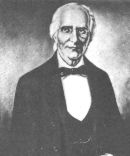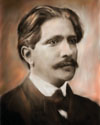
Luis Arístides Fiallo Cabral (8 May 1876 – 20 March 1931 in Santo Domingo) was an astronomer, medical laboratory scientist, physician, lawyer, architect, writer, philosopher and politician from the Dominican Republic. [1] [2]

Luis Arístides Fiallo Cabral (8 May 1876 – 20 March 1931 in Santo Domingo) was an astronomer, medical laboratory scientist, physician, lawyer, architect, writer, philosopher and politician from the Dominican Republic. [1] [2]
Born on 8 May 1876, his parents were Juan Ramón Rodríguez Fiallo and Ana María Cabral y Figueredo—a sister of Marcos Antonio Cabral y Figueredo. He was brother of poet Fabio Fiallo, uncle of both fashion designer Oscar de la Renta and physician and political activist Viriato Fiallo, grandnephew of President José María Cabral y Luna, first-cousin once-removed of Larimar Fiallo (Miss Dominican Republic 2004), and both great-great-grandfather and 1st cousin-thrice removed of film director José María Cabral González.
He married on 27 December 1900 to Flor de María Gregoria Henríquez García (1879–1963), the daughter of poet Federico Henríquez y Carvajal (1848–1952) and Carmen Amalia García Ricardo (1856–1894); his wife was niece of President Francisco Henríquez y Carvajal and cousin of Camila and Pedro Henríquez Ureña. They had 7 children: Fior d’Aliza, Gracia Leda, Hostos (1903–1988), Isis, Telma (d. 1998), Urania (b. 1911), Safo Suleika (1915–2001).
Fiallo received every degree the University of Santo Domingo could offer.
Fiallo Cabral was member of the Académie des sciences et lettres de Montpellier and the Société Française de Dermatologie . Fiallo was deputy for the Dominican Republic Congress, Dean of the Faculty of Medicine of the University of Santo Domingo, and President of the Dominican Society of Geography. He was the author of the Theory of Biocosmic Universal Gravitation.
Fiallo died on 20 March 1931 in Santo Domingo. The Dominican government declared five days of national mourning.

Óscar Arístides Renta Fiallo, known professionally as Oscar de la Renta, was a Dominican fashion designer. Born in Santo Domingo, he was trained by Cristóbal Balenciaga and Antonio del Castillo. De la Renta became internationally known in the 1960s as one of the couturiers who dressed Jacqueline Kennedy. He worked for Lanvin and Balmain. His eponymous fashion house has boutiques around the world including in Harrods of London and Madison Avenue in New York.
The Universidad Autónoma de Santo Domingo (UASD) is the public university system in the Dominican Republic with its flagship campus in the Ciudad Universitaria of Santo Domingo and with regional campuses in many cities of the Republic. It was founded by Jose Gabriel Garcia and Emiliano Tejera in 1866 as the Professional Institute, replacing the former Universidad Santo Tomás de Aquino, one of the first universities of the Western Hemisphere (Americas), which was founded unofficially by a Papal bull in 1538, officially by royal decree in 1558, and closed in 1822. It was later renamed University of Santo Domingo in 1914.
Salomé Ureña was a Dominican poet and an early proponent of women's higher education in the Dominican Republic.

Ulises Francisco Espaillat Quiñones was a Dominican author and politician. He served as president of the Dominican Republic from April 29, 1876 to October 5, 1876. Espaillat Province is named after him.
Arístides Sócrates Henríquez Nolasco was a writer from the Dominican Republic. He was born in what is now Enriquillo in Barahona Province on March 20, 1884, and died in Santo Domingo on July 2, 1980. The parents of Sócrates Nolasco were Juliana Nolasco and Manuel Henríquez y Carvajal. Some of his formative years, from 1906 to 1913, were spent in Cuba, in the city of Santiago de Cuba, and he later returned to that nearby country, to Havana, living there from 1951 to 1954.
Larissa del Mar Fiallo Scanlon, commonly known as Larimar Fiallo, is a Dominican beauty pageant titleholder who represented her country at the Miss Universe 2004 pageant.

Francisco Hilario Henríquez y Carvajal was a doctor, lawyer, writer, educator and politician from the Dominican Republic, who served as president just prior to the US occupation of the country. He married Salomé Ureña. He had 4 children, Pedro, Francisco, Max, and Camila.

The National Pantheon was built from 1714-1746 by the Spaniard Geronimo Quezada y Garçon and was originally a Jesuit church. The structure was constructed in the neoclassic-renaissance style. Today, the structure stands as a national symbol of the Dominican Republic and serves as the final resting place of the Republic's most honored citizens.
José María Cabral González is a Dominican film director, screenwriter, and producer.

Manuel Vicente Díez Cabral is a Dominican businessman and entrepreneurial leader.

Fabio Fiallo, in full Fabio Federico Fiallo Cabral was a Dominican writer, poet, politician, and diplomat, primarily known for his modernist short stories and verses, as well as being an outspoken anti-imperialist during the American occupation of 1916-1924. Intensely patriotic, he was one of the most prominent critics and leaders of the opposition to occupation, alongside Américo Lugo; though, as a result of his political writings, Fiallo was sentenced to 3 years of hard labor in 1920.
Viriato Alberto Fiallo Rodríguez born on 28 October 1895, died on 4 October 1983, was a Dominican doctor and politician of the twentieth century.
Marcos Ezequiel Antonio Cabral y Figueredo was a Dominican military officer, renowned writer, speaker, and president of the Dominican Republic. Cabral married his second-cousin Altagracia Amelia Báez Andújar, the daughter of President Buenaventura Báez, and begat 7 children: José María, Ramona Antonia, Casilda, Pablo, Buenaventura, Mario Fermín, and Altagracia Amelia Cabral y Báez.
Mario Fermín Cabral y Báez was a politician from the Dominican Republic. He was Senator for the Province of Santiago, and also the President of the Senate of the Dominican Republic three times: 1914–1916, 1930–1938, 1955.
Camila Henríquez Ureña, was a writer, essayist, educator and literary critic from the Dominican Republic who became a naturalized Cuban citizen. She descended from a family of writers, thinkers and educators; both her parents, Francisco Henríquez y Carvajal and Salomé Ureña, as well as her brothers Pedro and Max, were literary luminaries. Her essays have been published in Instrucción Pública, Ultra, Archipiélago, Casa de las Américas, La Gaceta de Cuba, Revista de la Biblioteca Nacional, Revista de la Universidad de La Habana, and Revista Lyceum. A feminist and a humanist, she lectured during much of her career, advocating intellectual study for women.
Federico Henríquez y Carvajal was a writer, journalist and teacher from the Dominican Republic.

José Gabriel García was a Dominican military, historian, politician, journalist and publisher. He is regarded as a cultural pioneer as well as the "Father of Dominican History". He is the author of "Compendium of History of Santo Domingo" written in four volumes in 1867, 1887, 1900 and 1906 respectively and made numerous contributions in the fields of culture, literature and education.
Juan Bautista 'Gianni' Vicini Cabral was an Italian Dominican businessman, chairman of Grupo Vicini.
Dr. Juan Vicente Moscoco Carvajal, nicknamed the "Dominican Socrates", was a lawyer, politician, educator and assessor of the royal artillery of Santo Domingo. He was mayor of Santo Domingo during the period of España Boba, among other public offices. He obtained a doctorate of canon law and civic law from the University of Santo Tomas de Aquino in 1791.